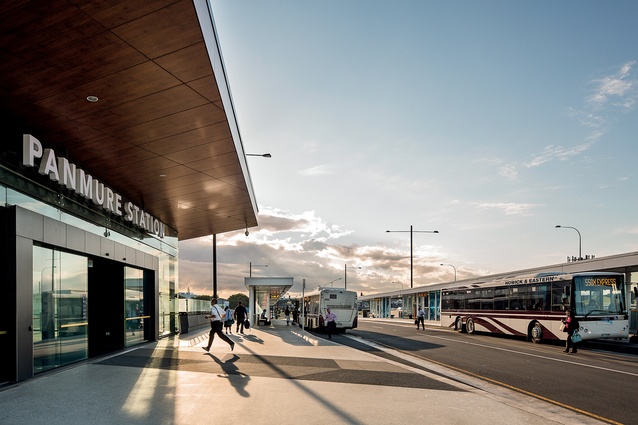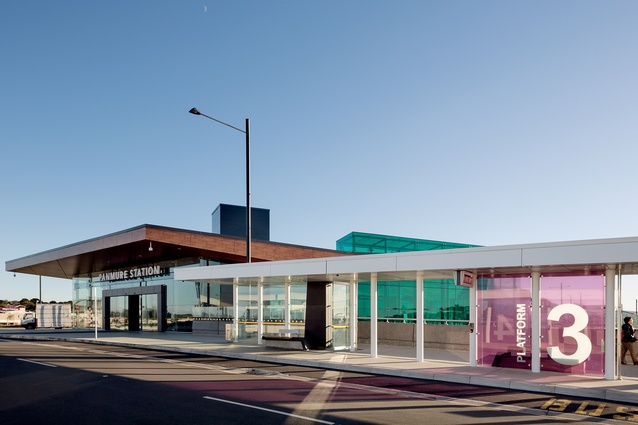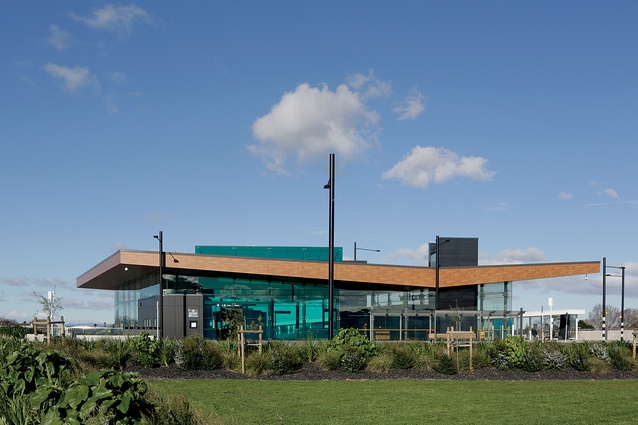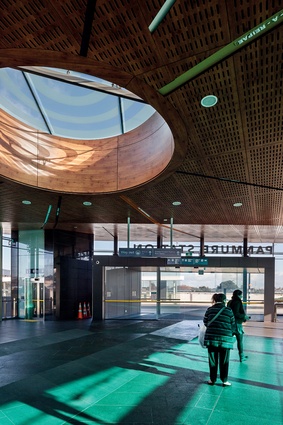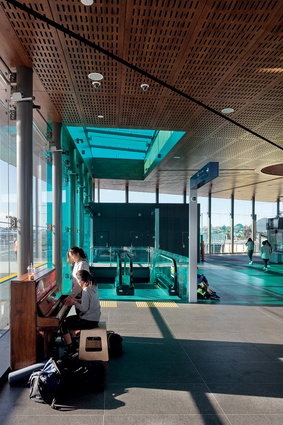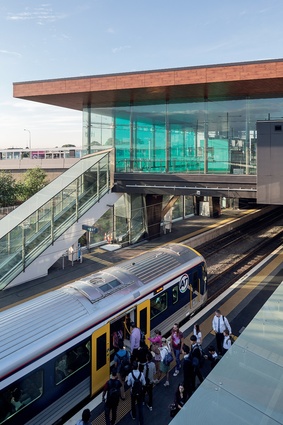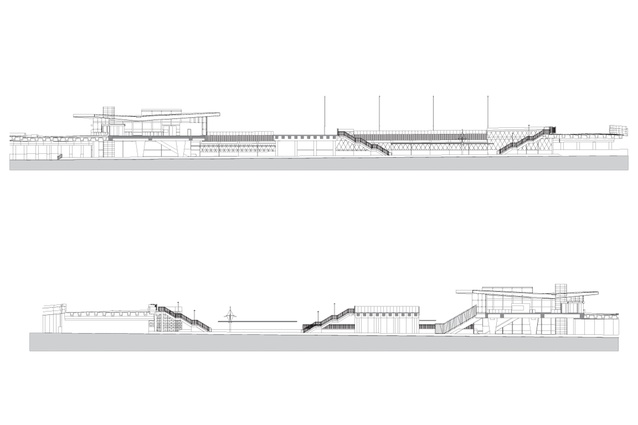Modern transport: AMETI Panmure Interchange
Opus Architecture’s elegant new interchange salutes the wonder of the new electric trains that whisk through Auckland and the improving transport amenity throughout the city.
Sheltering in the lee of the doughty Maungarei (Mt Wellington), the glittering new $17.5-million Panmure Interchange opened in January 2014: a jewel in the crown of the Auckland Manukau Eastern Transport Initiative (AMETI). Designed to service burgeoning population growth and concomitant residential development in the south-eastern area, it currently welcomes 1,700 daily commuters.
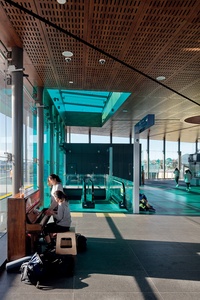
The concourse is clad in low emissivity glass and its transparency ensures it is a sunny and warm hub by day and, like the rail platforms below, cheerfully lit at night. It salutes the wonder of the conducted electricity which powers the many trains whisking through and is the perfect poster child for 2015 as the International Year of Light.
The concourse is just one of nine components to the Panmure project, which bristles with acronyms suggesting speed and efficiency. Two lifts, escalators to both platforms and four sets of stairs define the main access points, and ticket machines have been installed on both platforms with a staffed ticket office on the ground floor. Cyclists can stow their bikes in the station and there is a sunny plaza outside anticipating future market days.
Bus shelters placed along the RTN (Rapid Transit Network) road outside are characterised by blue and purple colouring and outsized numeral decals to direct pedestrians to the platforms along the adjacent busway. Here, they can admire the functional minimalism as they pick up a fast bus connection to Botany, Howick or Pakuranga.
Beautifully designed by Opus Architects to be both elegant and robust, these bus shelters not only withstand graffiti raiders and vandalism but also offer passengers weather protection under a soffit which is subtly patterned by alternating matt and gloss finishes. Arranged parallel to the Ellerslie-Panmure Highway and less than a minute’s walk from the station, the seating and upright structure of these bus stops incorporate basalt in reference to the area’s defining 135m peak. L–shaped bands of black sit over concrete slabs, with slatted wooden seating atop and angled steel back and armrests. While waiting for buses, those seated have the option of facing into a south-westerly or dodging it by sitting on the northeast-facing side of the shelter and gazing upon the mountain.
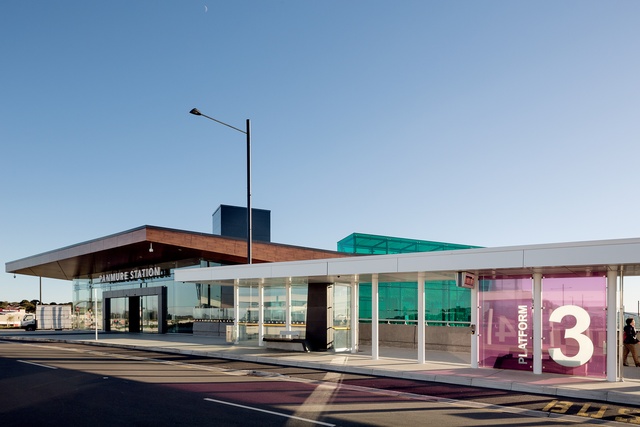
The largest of Auckland’s scoria cones, Maungarei is also the youngest onshore volcano, having been formed by an eruption around 10,000 years ago, and the modernity of the Panmure Interchange is an appropriate complement to the mountain’s energy and might.
Mt Wellington’s centrality is recognised within the concourse building by a green line identifying it as Maunga-a-Reipae, part of a compass rose with coloured lines pointing to historical landmarks and orienting travellers to the cardinal directions of north (raki), south (tonga), east (rāwhiti) and west (uru). The symbolism of the palette used refers to elements of historical usage of the site, including its role as a way station in the customary portage route for iwi carrying waka between the Waitematā and Manukau Harbours.
The various elements of water in the surrounding landscape – to the west, the Tāmaki River, Te Wai o Taiki, the Tainui spring, the Manukau Harbour, the Waipuna spring and the Panmure Basin or Kaiahiku – are indicated by blue veins radiating out from an oculus in the roof which pools light in the centre of the concourse.
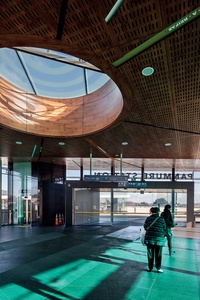
Reference is made to the human history of the Kohimarama block, with its purchase from Ngāti Paoa in 1841, and Felton Mathew’s survey of ‘Tehmaki’ into 37 farms totalling 3,856 acres, which included the Fencible settlement of Panmure, between Maungarei and the Tāmaki River.
Commemorated by an orange directional line in the concourse, the Royal New Zealand Fencible Corps was made up of 2,500 retired soldiers from Britain and Ireland, who enlisted between 1847 and 1852 as a military reserve to act as a ‘defence force’ for the protection of the early settlers in the fledgling town of Auckland. Each of the Fencibles was provided with a cottage and an acre of land, which they came to own after serving for seven years.
An early Māori traveller is also commemorated; the route taken in legend by a kārearea, New Zealand falcon or sparrowhawk, carrying a Māori princess on its back from Mount Pirongia in the Waikato to Te Whara or Bream Head in the north is picked out by a white line overhead. Geometric patterns from taonga inflect the walls of the road tunnel and the paving of the plaza.
As well as these pointers to cultural and natural history, there has been much attention paid to controlling the environment. Louvres are designed to open once the temperature builds inside the concourse and emissions from the road tunnel beneath Te Horeta Road (identified as an LCN (Local Connector Network) road in the plans) are dispersed by strategic openings at the back of the rail platform.
Screening the concrete walls on the platforms are abundant vines of Tecomanthe speciosa, the Three Kings Climber, which is flourishing with plenty of sunshine and rainwater harvested from the channels above. It makes the Panmure Interchange into a green and lively symbol of Auckland Council’s commitment to developing a modern infrastructure that will be the key to the city’s growth.

